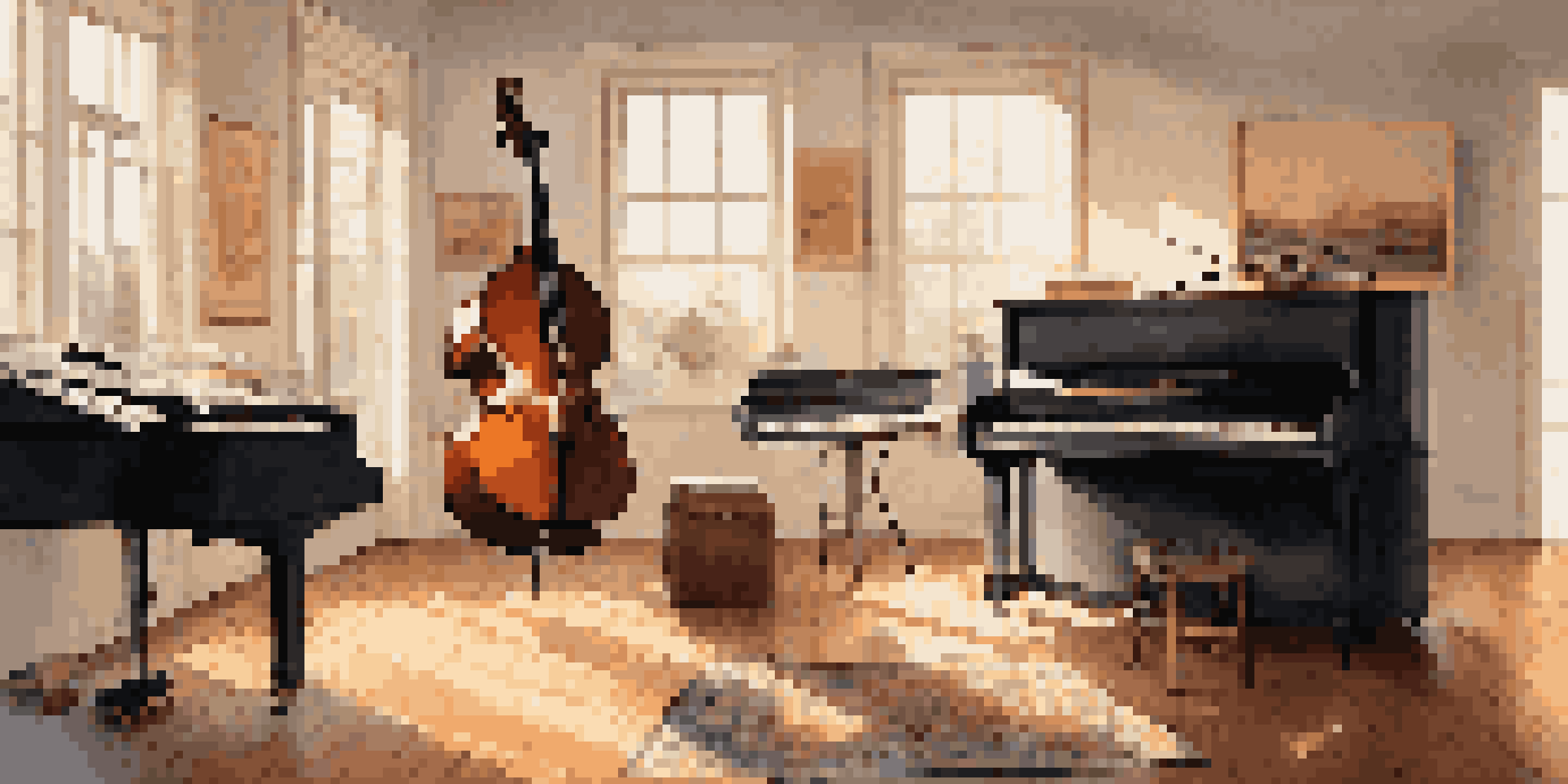The Role of the Bassline in Creating Musical Depth

Understanding the Basics of Basslines in Music
A bassline is the foundation of a piece of music, providing rhythm and harmony. It typically consists of lower-pitched notes that complement the melody. Think of it like the sturdy base of a house; without it, the structure would be weak and unstable.
The bassline is the foundation of any good piece of music; it holds everything together.
In many genres, the bassline serves as the backbone, guiding the listener's ear through the composition. It helps establish the song's overall groove and feel. When you listen to your favorite tracks, notice how the bass interacts with other instruments to create a cohesive sound.
Understanding the role of basslines allows musicians to craft more engaging songs. This awareness can also enhance the listening experience for fans, who may start to appreciate the intricacies of the music more deeply.
The Emotional Impact of a Strong Bassline
Basslines are powerful tools for evoking emotions in listeners. A deep, resonant bass can create feelings of intensity and urgency, while a lighter, melodic bassline might evoke joy or nostalgia. This emotional connection is often what makes a song memorable.

For instance, think about how the bassline in a ballad can elicit tears, while a funky bass groove can make you want to dance. The emotional spectrum is vast, and the bassline plays a crucial role in navigating it. It’s like the heartbeat of a song, dictating the emotional pace.
Basslines Create Musical Foundation
A bassline serves as the backbone of music, providing rhythm and harmony that complement the melody.
Musicians often experiment with different bass techniques to achieve the desired emotional effect. Whether it's a walking bass in jazz or a driving bass in rock, the choices made can significantly alter how a piece resonates with its audience.
Basslines as the Foundation of Genre Distinction
Different music genres often have distinct bassline characteristics that define their sound. For example, in reggae, basslines typically feature off-beat rhythms that create a laid-back vibe. In contrast, electronic dance music frequently employs driving basslines to energize the dance floor.
Music is the shorthand of emotion, and the bassline is the heartbeat that communicates those feelings.
Understanding these genre-specific traits helps musicians innovate while staying true to their roots. By experimenting within these frameworks, artists can create fresh sounds that still feel familiar to listeners. It’s a balancing act between tradition and innovation.
This genre distinction also helps listeners identify and connect with their favorite styles. A well-crafted bassline can transport you to a specific time and place, making it an essential element in the storytelling aspect of music.
The Role of Basslines in Creating Musical Tension
Basslines can create tension and release, which are fundamental components of music. By using techniques like syncopation or playing against the melody, basslines can build anticipation. This adds a layer of complexity that keeps listeners engaged.
Imagine a suspenseful movie scene where the music swells, and you can feel the tension in the air. The bassline often plays a pivotal role in creating that atmosphere. It can draw listeners in, making them lean forward in their seats, eager to hear what comes next.
Emotional Power of Basslines
Basslines evoke emotions, with different styles capable of inducing a range from joy to intensity in listeners.
Once the tension reaches its peak, a satisfying resolution often follows. This interplay between tension and release is a key reason why certain songs resonate so deeply with audiences, leaving them wanting to hear more.
The Interplay Between Basslines and Other Instruments
Basslines do not exist in a vacuum; they interact dynamically with other instruments to create musical depth. The relationship between the bass and the drums, for example, is crucial for establishing rhythm. Together, they form a tight-knit unit that propels the song forward.
The synergy between the bass and melody can also produce rich harmonies. When played correctly, the bassline enhances the overall sound, adding layers that make the music feel fuller. It’s akin to a painter using different shades to create depth in a landscape.
Musicians often experiment with these interactions to find the perfect balance. By understanding how basslines complement other instruments, they can create arrangements that are both interesting and sonically pleasing.
The Evolution of Basslines Through Music History
Basslines have evolved significantly over the centuries, reflecting changes in musical styles and technology. In classical music, for instance, the double bass played a vital role in orchestral arrangements, providing depth and grounding the harmony. As genres like jazz and rock emerged, the bass guitar became a staple, allowing for greater versatility.
With the advent of electronic music, producers began to experiment with synthesized basslines, leading to entirely new sounds. This evolution showcases how the bassline adapts to cultural shifts, continually finding ways to resonate with audiences. It’s a testament to the creativity of musicians across generations.
Basslines Define Musical Genres
Distinct bassline characteristics help define various music genres, allowing for innovation while honoring tradition.
Understanding this evolution helps us appreciate the bassline's role in contemporary music. It’s not just about the notes played; it’s about how those notes fit into the broader musical landscape.
Tips for Crafting Effective Basslines in Your Music
Creating an effective bassline requires a balance of creativity and technique. Start by establishing a strong rhythmic foundation; this will serve as the heartbeat of your song. Experiment with different patterns and syncopations to find what fits best with your melody.
Listening to a variety of genres can also provide inspiration. Pay attention to how different artists use basslines to enhance their music, then consider how you can incorporate similar techniques in your own work. It's like learning from masters in a craft; every little bit of inspiration helps shape your unique sound.

Finally, don't be afraid to iterate and refine your bassline. Sometimes, the best ideas come after several rounds of experimentation. Keep in mind that a strong bassline can elevate your music, adding depth that resonates with your audience.